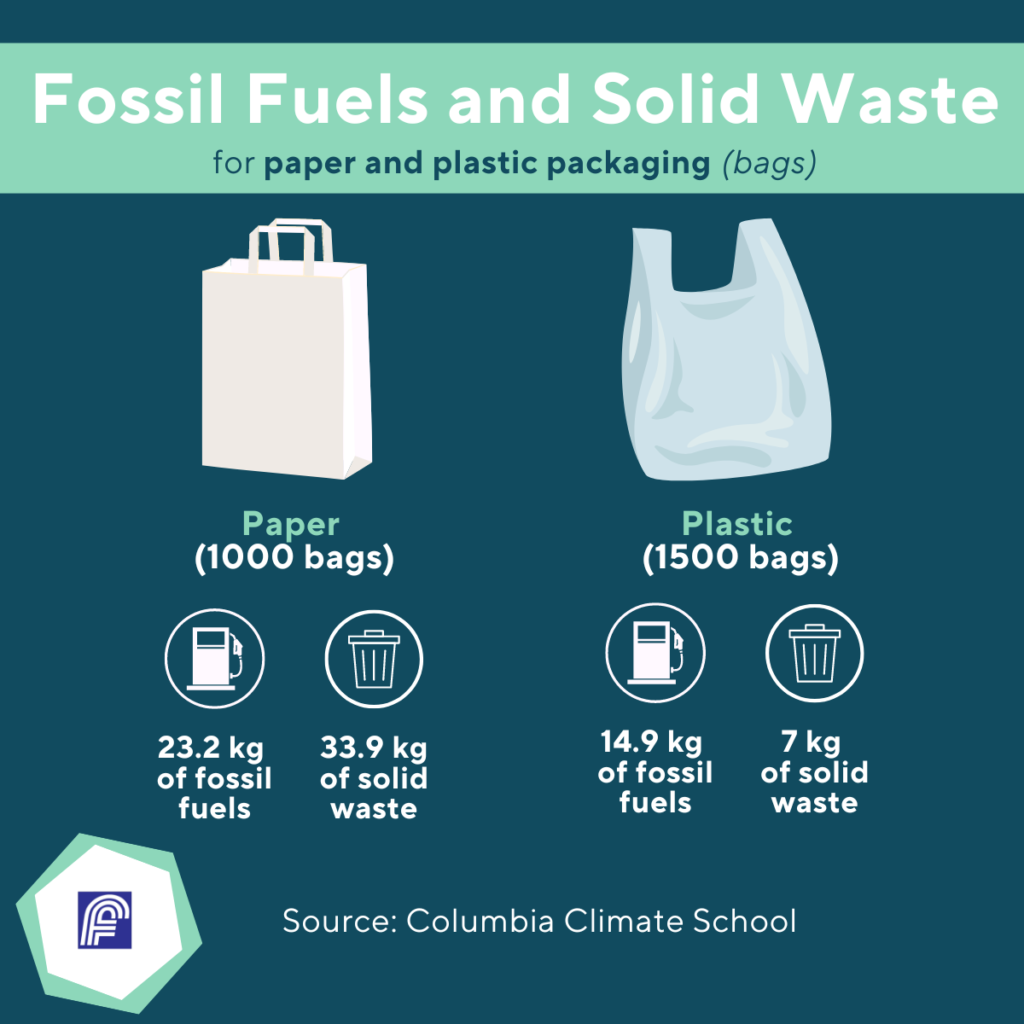

380 million tons of plastic waste and 85 million tons of paper waste are produced yearly worldwide (as per World Bank and US Environmental Protection Agency) highlighting the need for recycled materials in packaging. Using materials with Post-Consumer Recycled (PCR) is essential to complete the recycling loop and lower environmental impact. Read further to learn how to ship the right way…
The debate between plastic and paper packaging often focuses on the environmental repercussions of each. While plastic waste contributes significantly to landfills and persists for centuries, paper production is not without its faults.
The manufacture of paper involves large amounts of water and hazardous chemicals, resulting in considerable ecological harm.
According to an analysis by The Washington Post, paper production is responsible for 70 percent more air pollution and 50 times more water pollution than plastic bag production.
Ultimately, single-use packaging, whether plastic or paper, is the least sustainable option.
The best way to mitigate environmental impact is to maximize the reuse of any packaging material and ensure proper recycling at the end of its lifecycle. Only this approach minimizes waste and reduces the overall environmental footprint of packaging.
The process of producing paper is also resource-intensive. After trees are felled, the logs can sit for up to three years before processing. The wood undergoes chipping, heating, and treatment with chemicals like limestone and sulfurous acid to produce pulp. This pulp is then washed, bleached, and pressed into paper. Furthermore, products such as envelopes are subject to stages of folding and gluing, where cut shapes are folded along pre-scored lines and glued to form envelopes.
A great sustainable innovation in the field of paper packaging is the use of FSC-certified recycled fiber and pulp. Delivered by the Forest Stewardship Council, this certificate meets rigorous quality standards and ensures responsible forest management, making it an ideal choice for high-quality, sustainable products.
This eco-friendly alternative, crafted from post-consumer waste and endorsed by the Forest Stewardship Council, represents a significant leap forward in sustainable packaging. Not only does FSC recycled paper adhere to stringent quality benchmarks, but it also champions responsible forest stewardship practices. By embracing FSC-certified recycled paper, companies can mitigate the environmental impact of their packaging while delivering products that resonate with environmentally conscious consumers.
Studies in Europe and North America summarized by Yale Scientific indicate that, when considering the entire lifecycle, plastic packaging may be less harmful to the environment than paper, provided the latter is not reused multiple times.
Although plastic causes considerable damage on aquatic ecosystems and exhausts natural resources, when not recycled or disposed properly, improper paper waste management leads to increased algae blooming.
When paper ends up in water bodies, it breaks down and releases organic materials, including nitrogen and phosphorus, which are key nutrients for algal growth.
As found by scholars from the University of North Carolina (Wilmington), this nutrient enrichment, known as eutrophication, can lead to rapid algal proliferation, forming algal blooms. Those blooms block oxygen and sunlight intake, devastating underwater plant life. Additionally, the chemicals involved in virgin paper production are exceedingly toxic to both humans and terrestrial environments.
Biodegradable plastic remains scarce, yet plastic’s recyclability offers a distinct advantage. Plastic packaging, often derived from petroleum products, can be repurposed multiple times, even as trash bags after its initial use. Conversely, paper, especially when contaminated or coated with plastic, is challenging to recycle.
For instance, a Columbia Climate School’s study comparing the carrying capacities of 1,000 paper bags to 1,500 plastic bags revealed significant environmental disparities. The manufacture of plastic bags required 14.9kg of fossil fuels, compared to 23.2kg for paper bags. Plastic bags generated 7kg of municipal solid waste, whereas paper bags produced 33.9kg.

Furthermore, greenhouse gas emissions from plastic bags were half those of paper bags, and the water usage for plastic bags was a mere fraction of that for paper—58 gallons compared to 1,004 gallons. The energy consumption was also markedly different, with plastic bags using 763 megajoules of energy against paper’s 2,622 megajoules.
When evaluating the use of recycled materials, it’s crucial to understand the difference between Post-Industrial Waste (PIW) and Post-Consumer Waste (PCW).
Post-Industrial Waste, also known as pre-consumer waste, is generated during production and manufacturing, prior to any consumer use. This type of waste typically comprises uncontaminated, mono-materials of known composition, making it easier to recycle with minimal loss of quality.
This type of waste is, in fact, more prevalent in recycling due to its accessibility and quality. Indeed, manufacturers can easily collect and recycle their own production by-products, which are usually clean and of consistent composition.
Post-industrial Waste is indeed produced in almost every processing line, and can be more easily obtained and reused. It is more desirable by manufacturers, and as such has a higher value than post-consumer waste on the market.
On the other hand, Post-Consumer Waste refers to materials that have been used and discarded by consumers. This waste is often more varied and contaminated, presenting greater challenges in the recycling process.
Ultimately, the challenge is formed by Post-Consumer Waste’s irregular composition, contamination and variety, posing significant recycling challenges.
Post-Consumer Waste is thus more challenging to regrind, rework, and remanufacture. And that is why it is less favored by manufacturers and very often, this type of waste ends up in landfills if not properly recycled.

FILMAR chose to emphasize the use of Post-Consumer Recycled Content (PCRC) in order to ensure that the production of its shipping packaging solutions comes from a closed recycling loop. By focusing on PCRC, Filmar addresses the environmental aspect often neglected by other companies, while also reusing industrial by-products from their own production processes.
Switching from virgin materials to recycled materials offers several significant benefits for companies. It reduces the demand for raw resources, thereby lessening environmental impact. Using recycled materials also helps decrease waste and lowers greenhouse gas emissions associated with the production of virgin materials.
Furthermore, adopting recycled materials can enhance a company’s reputation by demonstrating a commitment to sustainability. This can attract environmentally conscious consumers and provide a competitive edge in the market. By embracing recycled materials, companies not only contribute to environmental conservation but also benefit from potential cost savings and improved brand image.
While Post-Industrial Waste is easier to recycle due to its availability and purity, focusing on Post-Consumer Recycled Content is essential for closing the recycling loop and addressing broader environmental concerns. By leveraging innovative production techniques and certified materials, we ensure high-quality, sustainable products that benefit both the environment and the businesses.

When it comes to shipping small or medium-sized items that need to lay flat, our ECO BUBBLE MAILERS are the ideal solution. Perfect for books, electronics, clothing, video games, smartphones, tablets, and accessories, these eco-friendly envelopes offer exceptional protection while prioritizing sustainability.
The design ensures that fragile items are cushioned during transit, providing peace of mind for both businesses and consumers who rely on quality packaging.
Crafted from FSC-certified 100% recycled paper and featuring an inner bubble film made from at least 70% recycled plastic (40% post-consumer recycled content), our recycled paper mailers highlight our commitment to environmental stewardship.
These recycled paper envelopes comprise up to 80% post-consumer waste, which ensures that materials are repurposed effectively, reducing the need for virgin resources. As a result, our ecological envelope solution not only minimizes waste but also supports a circular economy.
Fully recyclable and manufactured with Post-Consumer Recycled Content (PCRC), our mailers significantly reduce environmental impact, making them a top choice for eco-conscious businesses. By opting for these recycled mailing envelopes, companies can enhance their sustainability credentials and appeal to environmentally aware customers. The use of recyclable envelopes reflects a commitment to sustainability, ensuring that every shipped item contributes to a greener planet.
Available in various sizes, from 140×230+50 mm for compact electronics or small books to 250×350+50 mm for larger items, our padded mailers meet diverse shipping needs. These recycled paper envelopes are designed to cater to different packaging requirements, providing an eco-friendly solution without compromising on durability. If you need recycled and recyclable envelopes, our product range ensures that every need is covered with efficiency.
Choosing our mailers means selecting a product that excels in both sustainability and quality, ensuring robust and versatile protection for shipped items while supporting environmental responsibility.
Our recycled envelopes are crafted to provide superior protection, reducing the risk of damage during transit. By integrating those envelopes into your shipping processes, you contribute to a greener planet, making a significant impact through the use of eco-friendly materials and practices.
Enhance the sustainability and security of your shipments by opting for our recycled, bubble padded envelopes. Further streamline your logistics processes and go light by choosing our recycled poly mailers.
In conclusion, switching to recycled shipping packaging is a simple, yet effective way for companies to reduce their environmental impact and show their environmental commitment. Paper and plastics each have their drawbacks, yet it is the Post Consumer Recycled Content that offers the most viable path forward for the entire packaging industry, as it helps to minimize waste, reduce resource consumption, and promote a circular economy.
Furthermore, the European Regulation on Packaging and Packaging Waste (PPWR) mandates specific post-consumer recycled content targets for plastic packaging.
For any plastic part of packaging placed on the market, future requirements include a minimum of 10% recycled content for non-PET contact-sensitive packaging and 30% for PET contact-sensitive packaging. These percentages will increase significantly by 2040 to 25%, 50%, and 65%, respectively. Also the green claims will be legal to use only in case of packaging that exceeds the minimum requirements, and must be backed by a technical declaration.
Get ready now and comply with the new targets, choose FILMAR’s packaging solutions!
Discover our certified, sustainable shipping envelopes and poly mailers:
